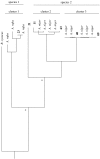Towards writing the encyclopedia of life: an introduction to DNA barcoding
- PMID: 16214739
- PMCID: PMC1609222
- DOI: 10.1098/rstb.2005.1730
Towards writing the encyclopedia of life: an introduction to DNA barcoding
Abstract
An international consortium of major natural history museums, herbaria and other organizations has launched an ambitious project, the 'Barcode of Life Initiative', to promote a process enabling the rapid and inexpensive identification of the estimated 10 million species on Earth. DNA barcoding is a diagnostic technique in which short DNA sequence(s) can be used for species identification. The first international scientific conference on Barcoding of Life was held at the Natural History Museum in London in February 2005, and here we review the scientific challenges discussed during this conference and in previous publications. Although still controversial, the scientific benefits of DNA barcoding include: (i) enabling species identification, including any life stage or fragment, (ii) facilitating species discoveries based on cluster analyses of gene sequences (e.g. cox1 = CO1, in animals), (iii) promoting development of handheld DNA sequencing technology that can be applied in the field for biodiversity inventories and (iv) providing insight into the diversity of life.
Figures

References
-
- Armstrong K.F, Ball S.L. DNA barcodes for biosecurity: invasive species identification. Phil. Trans. R. Soc. B. 2005;360:1813–1823. 10.1098/rstb.2005.1713 - DOI - PMC - PubMed
-
- Besansky N.J, Severson D.W, Ferdig M.T. DNA barcoding of parasites and invertebrate disease vectors: what you don't know can hurt you. Trends Parasitol. 2003;19:545–546. 10.1016/j.pt.2003.09.015 - DOI - PubMed
-
- Blaxter M. Counting angels with DNA. Nature. 2003;421:122–124. 10.1038/421122a - DOI - PubMed
-
- Blaxter M.L, et al. A molecular evolutionary framework for the phylum Nematoda. Nature. 1998;392:71–75. - PubMed
-
- Blaxter M, Elsworth B, Daub J. DNA taxonomy of a neglected animal phylum: an unexpected diversity of tardigrades. Proc. R. Soc. B. 2004;271:S189–S192. 10.1098/rsbl.2003.0130 - DOI - PMC - PubMed
Publication types
MeSH terms
Grants and funding
LinkOut - more resources
Full Text Sources
Other Literature Sources
